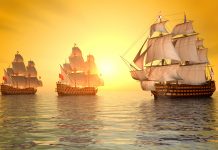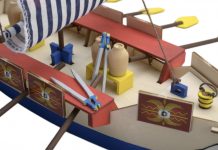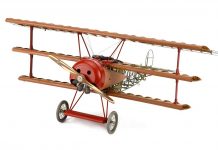A Truly First Rate Ship: The Legend of Lord Nelson’s HMS Victory
Now nestled in the historic dockyard at HMNB in Portsmouth, the HMS Victory is arguably Britain’s most celebrated warship. Though its international recognition is rightly attributed to the moment of triumph during the Battle of Trafalgar, in truth its story is much longer than that one fateful day. Still considered a model of naval excellence 250 years on, join us as we explore the origins of one of Britain’s finest ever ships.
At 0600 hours on the morning of 21st October, Nelson split the British fleet into two columns in a ploy to damage the enemy line
The (Almost) False Start
Designed by Sir Thomas Slade, commonly considered the greatest British naval architect of his time, the 100-gun, first-rate ship of the Royal Navy was ordered in 1758, laid down in 1759, and eventually launched on the 7th of May 1765 from the Chatham Dockyard in Kent.
It was here, before leaving the dockyard, that the HMS Victory narrowly avoided what would have been an untimely and utterly embarrassing demise. Fortunately for the ship and for all those involved in its construction, shipwright Hartly Larkin had a moment of blessed realisation on the morning of the launch – the Victory was going to be too wide to pass through the dockyard gates into the Medway.
With members of the navy and government invited to celebrate the ship’s launch mere hours later, Larkin confirmed the gaffe at the break of dawn – the Victory was 9.5 inches too wide. Rallying any and all available shipwrights, Larkin and the makeshift crew worked tirelessly with adzes to cut apart the frame of the dockyard gates. While the gates were left in a less than desirable state, the HMS Victory launched successfully, the esteemed attendees none the wiser of the narrowly avoided disaster.
Sadly for Larkin, the scale of this near miss was never recognised by the navy, and he received no reward for his last-minute brilliance. Asked to retire on a much smaller pension than he deserved, Larkin never lived to see the Victory’s moment of glory, passing away in 1803.
All Dressed Up with Nowhere to Go
With the Victory out in open water, one would presume she would be sent into battle almost instantly, right? Wrong. Though she was fighting fit and ready to defend Britain’s trading exploits, she was to remain inactive and stranded in the Medway for a further 20 years.
While avoiding any undue risk from enemy skirmishes, the Victory still sustained damage during this time, and had to be docked on two occasions to undergo urgent repairs to avoid sinking.
Source: http://www.kent-life.co.uk/home/hms_victory_and_her_medway_story_1_4004999
The Victory’s Moment of Glory
Though the Victory was used extensively over the following 20 years and beyond, there is one reason that it remains such an iconic piece of British naval history – the Battle of Trafalgar. Amidst the Napoleonic War, off the South Western coast of Spain, Vice-Admiral Lord Horatio Nelson flew his flag on the Victory as 32 British ships engaged 23 French and 15 Spanish ships.
At 0600 hours on the morning of 21st October, Nelson split the British fleet into two columns in a ploy to damage the enemy line. These two columns closed in on the French line, albeit slowly, before the Royal Sovereign got within range to open fire on the Fougueux. Following shortly behind, the Victory broke through the Bucentaure and Redoubtable, firing a treble shot into the stern of the former. Despite suffering 57 killed and 102 wounded, the Victory finished triumphant, securing the battle for the Royal Navy. She was never again to take part in a battle of this scale, but the Victory’s success here placed her highly in British naval history.
Source: https://en.wikipedia.org/wiki/HMS_Victory
The Unfortunate Death
At a quarter past one, with the HMS Victory engaged in brutal close-quarters combat with the Redoubtable, tragedy struck. Amid the chaos of point-blank gunfire hurtling through the air from both ships, a French sharpshooter picked out Lord Nelson. The musket ball pierced Nelson’s left shoulder with tremendous force, tearing a straight line through to his lower spine.
As he lay there on the deck, Nelson found Captain Thomas Hardy, whom he had been walking with at the time of the mortal shot. Gallant as ever; he uttered “They have done for me at last, Hardy.” He passed away at half past four.
Source: http://www.eyewitnesstohistory.com/lordnelson.htm
The HMS Victory sailed on many more expeditions post Trafalgar, with her active career eventually finishing on the 7th November 1812. Along with the rest of the Royal Navy’s fleet at the time, the Victory was hugely influential in protecting Britain’s major trade lines. London’s power in the 18th century was built on its sea-bound trading, and it is because of ships like the HMS Victory that this power remained undeterred.
250 years on, the HMS Victory remains a source of inspiration for naval enthusiasts and scale model makers the world over. At ModelSpace we are proud to keep this beautiful ship in the minds and hearts of generations. Capture the majesty of Lord Nelson’s HMS Victory for yourself, with our 1:84 replica, available here: http://www.model-space.com/gb/build-the-hms-victory.html






